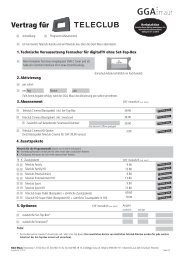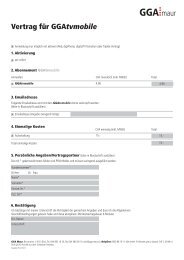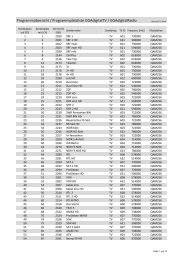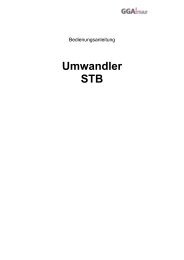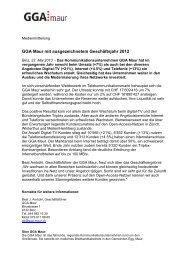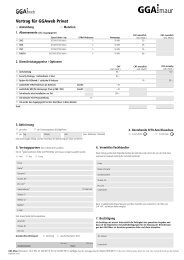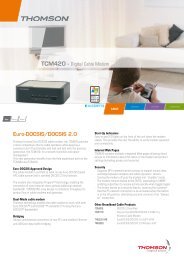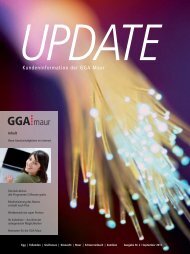Prestige 964 Cable Router Operator's Guide - bei GGA Maur
Prestige 964 Cable Router Operator's Guide - bei GGA Maur
Prestige 964 Cable Router Operator's Guide - bei GGA Maur
Create successful ePaper yourself
Turn your PDF publications into a flip-book with our unique Google optimized e-Paper software.
<strong>Prestige</strong> <strong>964</strong> <strong>Cable</strong> <strong>Router</strong><br />
10BaseT<br />
ARP<br />
Authenticity<br />
Back Door<br />
Backbone<br />
BackOrifice<br />
Bandwidth<br />
Bit<br />
Brute Force Hacking<br />
Byte<br />
<strong>Cable</strong> Modem (CM)<br />
Camping Out<br />
CATV<br />
CDR<br />
Channel<br />
CHAP<br />
Cipher Text<br />
Client<br />
CMTS<br />
The 10-Mbps baseband Ethernet specification that uses two pairs of twisted-pair cabling<br />
(Category 3 or 5): one pair for transmitting data and the other for receiving data.<br />
Address Resolution Protocol is a protocol for mapping an Internet Protocol address (IP address) to<br />
a physical machine address that is recognized in the local network.<br />
Proof that the information came from the person or location that reportedly sent it. One example<br />
of authenticating software is through digital signatures.<br />
A deliberately planned security breach in a program. Back doors allow special access to a<br />
computer or program. Sometimes back doors can be exploited and allow a cracker unauthorized<br />
access to data.<br />
A high-speed line or series of connections that forms a major pathway within a network.<br />
BackOrifice is a remote administration tool which allows a user to control a<br />
computer across a TCP/IP connection using a simple console or GUI application. BackOrifice is<br />
a potentially disastrous Trojan horse since it can provide the user unlimited access to a system.<br />
This is the capacity on a link usually measured in bits-per-second (bps).<br />
(Binary Digit) -- A single digit number in base-2, in other words, either a 1 or a zero. The<br />
smallest unit of computerized data.<br />
A technique used to find passwords or encryption keys. Force Hacking involves trying every<br />
possible combination of letters, numbers, etc. until the code is broken.<br />
A set of bits that represent a single character. There are 8 bits in a Byte.<br />
A cable modem is a device that enables you to hook up your computer to a local cable TV line<br />
and receive data at about 1.5 Mbps. This data rate far exceeds that of the prevalent 28.8 and 56<br />
Kbps telephone modems, and up to 128 Kbps of ISDN that is about the data rate available to<br />
subscribers of Digital Subscriber Line (DSL) telephone service. A cable modem can be added to<br />
or integrated with a set top box that turns your TV set into an Internet channel. For computer<br />
attachment, the cable line must be split so that part of the line goes to the TV set and the other<br />
part goes to the cable modem and the computer.<br />
A cable modem is more like a network interface card (NIC) than a computer modem. All of the<br />
cable modems attached to a cable TV company coaxial cable line communicate with a <strong>Cable</strong><br />
Modem Termination System (CMTS) at the local cable TV company office. All cable modems<br />
can receive only from and send signals to the CMTS, but not to other cable modems on the line.<br />
Staying in a "safe" place once a hacker has broken into a system. The term<br />
can be used with a physical location, electronic reference, or an entry point for future attacks.<br />
<strong>Cable</strong> TV system. Can be all coaxial- or HFC- (Hybrid Fiber Coax) based.<br />
Call Detail Record. This is a name used by telephone companies for call related information.<br />
A specific frequency and bandwidth combination. In the present context, it means TV channels<br />
for television services and downstream data for cable modems.<br />
Challenge Handshake Authentication Protocol is an alternative protocol that avoids sending<br />
passwords over the wire by using a challenge/response technique.<br />
Text that has been scrambled or encrypted so that it cannot be read without deciphering it. See<br />
Encryption<br />
A software program that is used to contact and obtain data from a Server software program on<br />
another computer. Each Client program is designed to work with one or more specific kinds of<br />
Server programs, and each Server requires a specific kind of Client. A Web Browser is a specific<br />
kind of Client.<br />
<strong>Cable</strong> Modem Termination System. A central device for connecting the cable TV network to a<br />
data network like the Internet. Normally it is placed in the headend of the cable TV system.<br />
Glossary of Terms<br />
Cookie<br />
Countermeasures<br />
CPE<br />
Cracker<br />
A string of characters saved by a web browser on the user's hard disk. Many web pages send<br />
cookies to track specific user information. Cookies can be used to retain information as the user<br />
browses a web site. For example, cookies are used to 'remember' the items a shopper may have in<br />
a shopping cart.<br />
Techniques, programs, or other tools that can protect your computer against threats.<br />
Customer Premises Equipment. Used to describe the computer and/or other equipment that the<br />
customer may want to connect to the cable modem.<br />
Another term for hackers. Generally, the term cracker refers specifically to a person who<br />
maliciously attempts to break encryption, software locks, or network security.<br />
Glossary<br />
C



